Ames Reel Easy Cassette Portable Hose Reel With 60 Hose Reviews
Who this is for
The ruins of Roman aqueducts have pretty well established humankind's need to transport water, so it's not necessary to list the humble garden hose's many uses, from agriculture to yardwork (we couldn't think of a z word). Let's focus instead on who will find this guide useful. This guide is for anyone who has felt the impotent dribble of a hopelessly tangled hose, crushed a flimsy coupling beneath a car wheel, seen a cheap hose kink and fold like a deflated balloon, or watched water leak from a spigot connection that won't turn any tighter. If you've ever stood in your driveway while sweating and screaming at your hose, you are not alone, and we are here to help. Our goal is to recommend a versatile rig with all the spray patterns you could ever need, in a setup that's so easy to use, you'll be looking around the yard for something else to hose off.
How we picked

To find hoses worth testing, we started by looking at every popular model on the shelf and online at stores including Home Depot, Lowe's, and some local Ace franchises, and we waded into the wider ocean of Amazon's offerings. We consulted with experts at a local home garden center, asked our neighbors and friends what they used, talked specs and materials with hose manufacturers, and examined the hardware at the finest car washes of East Los Angeles. We've also been using hoses our entire lives: Wirecutter senior editor Harry Sawyers is a former pro landscaper who now has several hoses snaking around his house in Los Angeles; staff writer Thom Dunn grew up adhering to his father's meticulous lawn-care regimen, which was the stuff of legends in Connecticut's New Haven County; and senior staff writer Doug Mahoney raises sheep, cows, pigs, and chickens in New Hampshire, making him a year-round hose user as he keeps all those critters hydrated. In our research, a quote from our interview with Genevieve Schmidt—a garden writer and owner of a landscaping company in Northern California—was a common refrain: "Every hose brand will kink, but some brands are better than others."
That experience led us to demand adherence to just two strict criteria, both of which served as hallmarks of overall quality and reduced our test pool to a manageable number.
Flat facets at the couplings: We wanted a hose to have a nutlike hexagonal metal point in its coupling, the part that screws on to the spigot. This one feature, more than any other, is the thing that separates the good from the garbage. If the manufacturer has specified that detail (rather than a rounded, ridged coupling, like the cap of a soda bottle), it usually also means the hose's coupling has other desirable features: It's unlikely to get crushed or deformed under a boot heel or car wheel, unlikely to corrode or lose its finish, unlikely to leak, and unlikely to get stuck—the whole point of those flat facets is to give you a place to put a wrench on it to free the hose when it's screwed on too tightly, your hands are too wet, or you're just too tired from doing yardwork all morning to disconnect the hose without a little mechanical advantage.
Made in the USA: This wasn't a requirement when we started our search, but it came to be a reliable barometer of quality, not for nationalistic reasons. If the hose is made in the United States, that almost definitely means the company is based in the United States, which takes customer service from being an abstract concept to an entity you might actually be able to contact if you have a problem. Plus, more than most product categories, garden hoses present a lot of US-made options for your consideration. We weren't closed off to the alternatives, but considering the rich pool of candidates available within this class, we didn't feel the need to look under every rock around the world for a marginally better option.
There were also a couple of common features that we didn't prioritize. We didn't take claims of "kink-free" or "kink-proof" all that seriously. We also didn't put much stock in any claims of a hose's being "drinking-water safe," even if the materials may be safe for drinking-water use in theory. Dramm's packaging sums it up well: "Garden hoses can come into contact with harmful chemicals often used with nozzles, garden sprayers, or chemicals used on lawns. The inside of the hose is dark, damp, and warm, causing bacteria to form." A hardware-store employee we interviewed about hoses recalled fond memories of youthful summer days spent lapping water from his parents' hose, and even though the Rockwell-esque image was lovely, we have recommendations for better ways to drink water in the wild.
We didn't require a certain hose size, but our research steered us toward the standard, 50-foot length for general-purpose use. A 25-foot hose can barely run around a car and back, and a 100-foot hose can be difficult to handle, but a 50-footer should be enough to cover most suburban yards. If you need more than 50 feet, experts we spoke with recommended buying multiple hoses and connecting them—that way, if anything does break or leak, you have to repair or replace only one section instead of buying another long, expensive hose. Most garden hoses have a ⅝-inch diameter, so width wasn't a factor, although our tests did reveal subtle differences between the standard size and the smaller coiled option we considered.
How we tested

We've been testing garden hoses for years, in multiple locations. Our most recent tests encompassed months of use for routine home chores at senior editor Harry Sawyers's place in Los Angeles: pressure-washing the grit off the driveway and patio furniture, washing the car, watering plants, filling kids pools, and dousing the yard on July 4 (keeping our fingers crossed that a stray ember wouldn't set the bougainvillea ablaze). We also tested at senior staff writer Doug Mahoney's farm in New Hampshire. Between garden irrigation, supplying water for the animals, and general use, Doug estimates that he has seven to 10 hoses in operation during the summer. In the winter months this number decreases to two, but the task gets more challenging because the hoses need to be coiled after each use to prevent freezing.
We put hoses on our most cramped spigots and measured any leaks from the connections. And as we whipped the hoses around our properties, we paid attention to the texture of the hose material, as well as the knots and tangles and general maneuverability.
During testing, we drained and disconnected the hoses and re-coiled them, taking note of any memory (the tendency of an unrolled hose to retain its coiled shape) or any other stubbornness we encountered. In a 2019 test in Ithaca, New York, staff writer Thom Dunn dragged the hoses out to the street and drove a two-door Honda Civic back and forth over them several times, making sure to catch the fittings right beneath the wheels.

After peeling each flattened hose from the pavement, we put them all through the same series of tests on the front and back spigots again, checking for leaks, ill-fitting fittings, or other damage.
We also tested the amount of water each hose was capable of moving. We attached each hose to a sill cock and timed how long it took to fill a 5-gallon bucket, confirming a measurable difference in flow rate between different diameters of hoses.
In an even more brutal test, we put the hoses and nozzles in the hands of several children between the ages of 3 and 7. Carried out mostly in backyard pool battles and other mayhem, this test allowed the kids to drop, grab, kick, bury, submerge, jam, and generally use the tools in ways no adult ever would. We probably voided the warranties on everything, but we had to do this to be sure these hoses and nozzles could handle true abuse.
Alongside our ongoing tests, we have been evaluating the long-term durability of all the items we've recommended in this guide over time. Torture tests are fun, but nothing can quite compare to the real-life rigors of coiling, uncoiling, stretching, and storing a hose, or to the long-term degradation a hose endures over years of seasonal changes and sun damage. We've picked up a few tips on maximizing the life of a hose, too.
Our pick: Continental Commercial Grade Rubber Hose (50 feet)

Our pick
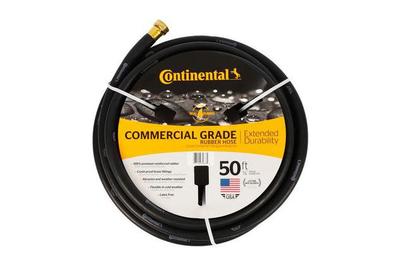
For a general-use, all-around reliable garden hose, we recommend the Continental Commercial Grade Rubber Hose. It has so little pizzazz, it's downright boring. It doesn't come in a variety of colors or have shiny couplings, but what it does offer are the things people require of a garden hose: reliability, flexibility, and durability. Through the years, we've featured a lot of picks in this guide, and we've found that problems with hoses like this usually don't show up until after a couple of years of use. But through all of our years of testing, the Continental has remained consistent in its performance. We can't say that it will never deteriorate over time, but we can say that it has been more dependable than the other hoses we've tested. We have Continentals in use that are 10 years old and still going strong.
The Continental hose's thick, abrasion-resistant wall is far tougher to cut or puncture than the walls on cheaper vinyl hoses, which we've seen lacerated by thorny bougainvillea shoots. Continental says the hose remains flexible to -40 degrees Fahrenheit. We (mercifully) could not test that claim, but we have used this hose throughout many New Hampshire winters, and we can verify that it stays flexible and usable in extreme temperatures (at least -20 °F).
During regular use, the Continental doesn't have a cheap hose's tendency to fold over or bind up if you're pulling it taut when it still has a few curls to unwind. We wouldn't call this hose kink-proof, but we would call it kink resistant: Work with it and make an effort to keep it straight, and it won't collapse into one of those water-blocking surprise kinks that make cheap hoses so frustrating.
The Continental hose's brass couplings have nice facets for a wrench to grip. One minor flaw in comparison with our runner-up, the Dramm hose, is that the Continental's hardware lacks nickel plating and has a slightly less robust connection to the hose. We've seen hoses go in and out of stock, so we like that the Continental has great, long-standing availability at Home Depot. Typically priced at $45 or so, it's an excellent value.
With all of our experience using the Continental hose in a wide variety of settings, we view it as one of those excellent and reliable things that, as long as you're not intentionally abusive, should last for years and years. As we said above, we have Continentals that we've been using for a decade, and they're still fine. So when we reach for the Continental hose, we do so with the comforting knowledge that our hose needs will be met, and that if there are any problems with our current project, they won't have anything to do with the hose we're using.
Flaws but not dealbreakers
At about 12 pounds, the Continental hose is heavy, and for some people it can be hard to manage without a reel, so plan on getting a reel, or you'll spend an excessive amount of time lassoing this hose each time you try to unwind it or store it. Because of that heft, the Continental can feel like overkill for a small patio or garden; in those spaces, a coiled hose might be a better option.
Upgrade pick: Eley 5/8-inch Polyurethane Garden Hose

Upgrade pick
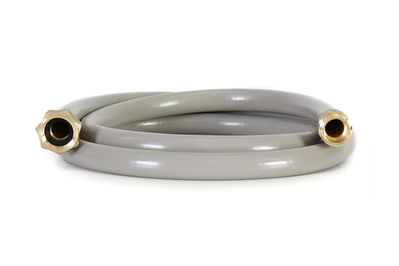
The Continental hose or the Dramm hose will fit the needs of most people, but if you're interested in a hose that is better in every way—and you're willing to pay for it—we also recommend the Eley 5/8-inch Polyurethane Garden Hose. Not to sound dramatic, but the Eley removes all of the minor inconveniences associated with a garden hose. We had no idea that a garden hose could be this nice. After we used the Eley hose for a while, other hoses felt clunky and cumbersome, as if they were generations old; using them felt like rubbing two sticks together to make fire, as opposed to flicking a well-worn Zippo. Compared with solid hoses like the Continental or Dramm, the Eley is lighter, looser, and more durable, and it's apparently immune to kinking (in our testing, at least).
Out of the box, the Eley hose was almost comically light. We were so used to lugging rubber hoses around that the Eley didn't even seem real. The biggest downside to rubber hoses is their weight, and the polyurethane Eley manages to shave 5 pounds off in comparison with the Continental, weighing about 7 pounds as opposed to 12. That's light for a durable garden hose. Spraying water with the nozzle at waist height, with 4 or 5 feet of the hose lifted off the ground, barely feels like anything with the Eley.
Adding to the ease of use is how flaccid the hose is. Rubber hoses are good in this regard, but the Eley is at another level. Looping it, lasso-style, to coil it up is especially easy, partly because of the lower weight but also because the loops don't have the kind of structured memory found on rubber hoses. With the Eley hose, the loops just fall into place.

In the time we used the Eley hose, we couldn't get it to kink. Even under some circumstances when we could get the Continental to sharply fold over itself, the Eley refused to succumb. But what's particularly nice is that when we wanted to kink the Eley—such as to stop the flow of water to put on a new hose nozzle—it was easy to do, and the hose didn't show any sign of tending to kink in that area again, a characteristic that marked the Dramm.
This hose also moved water faster than the others we tested, even the competing ⅝-inch hoses. Both the Continental and the Dramm filled a 5-gallon bucket in about 70 seconds. The Eley finished the same task in 55 seconds. The difference doesn't sound like much, and for small tasks, such as filling a 5-gallon bucket, it's not a big deal. But once you start filling larger things—topping off a swimming pool or 100-gallon livestock waterers, say—those seconds add up.
The hose is made of polyurethane; Eley equates it to the material used for the wheels of inline skates. The hose is durable, and the nice-looking brass fittings only exemplify that point. It's durable enough that Eley covers it with a 10-year warranty, whereas the company covered its now-discontinued rubber hose for only five years.
One downside to the Eley hose is that it is available only in a battleship gray, so it doesn't exactly disappear if left on a lawn, like a black hose does. Nor does it have the zesty pop of a colorful Dramm hose. "That thing is kinda ugly," one tester said when they saw it for the first time.
The Eley hose costs roughly $110 for a 50-foot length, a little over twice the cost of the Continental. There is no question that the Eley is a premium hose at a premium price, and before we tested it, we were wary of the cost. Now, having seen what the Eley offers, we're of a different mind. Not everyone needs the Eley hose, but its light weight and ease of use make it a good option for a lot of people, including those who might not be confident managing a much heavier rubber hose.
The Eley hose is available in set lengths from 6.5 feet all the way up to 200 feet. Eley can also create custom lengths for you.
Also great: HoseCoil ⅜-inch Self Coiling Garden Hose (25 feet)

Also great
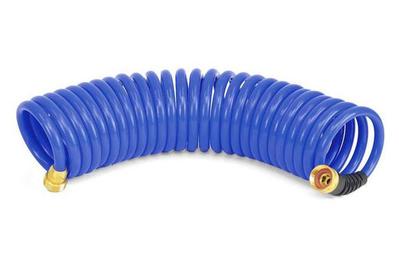
The HoseCoil ⅜-inch Self Coiling Garden Hose (25 feet) is nowhere near as heavy-duty as our Continental, Dramm, and Eley picks, but for a small patio or garden—where a big, 50-foot hose feels like overkill—it is a much more manageable option. This hose's primary distinction is its corkscrew-shaped coil, which extends to about 17.5 feet of its full 25-foot length when in use and then springs back to its original form like a classic telephone cord. No manual coiling, no reel winding, no hassle.
Whereas hoses like the Continental, Dramm, and Eley have a ⅝-inch interior diameter, the HoseCoil's is slimmer, at ⅜ inch. You will not be shocked to learn that this difference in size reduces the flow rate of the water. Such results are evident mostly in side-by-side tests, though, and a good nozzle can compensate for it. The HoseCoil has nice brass-alloy fittings. On the end that connects to the nozzle, you'll find generous facets for a wrench to grip. Curiously, however, there are no accessible facets on the spigot end, where in our experience the connection has been more likely to end up cramped or stuck; instead, the entire spigot-end area is dominated by a black plastic strain-relief sleeve.

Buyers seem to have fairly modest expectations for this hose, and considering the "good enough" theme we've spotted in the headlines of customer reviews, it apparently delivers in that regard. The most encouraging reviews describe similar hoses as lasting four and a half years or two and a half years, in line with our expectations. Long-term durability is the main concern, but in our ongoing tests, the HoseCoil has proved tough enough to last a year (and counting) stored on the south-facing wall of a Southern California house, enduring regular exposure to harsh UV conditions. Just be careful that the coil doesn't get twisted out of alignment, because returning it to the original crisp coil can be time consuming and frustrating.
Also great: Melnor XT451 Metal Nozzle
Also great: Gilmour Full Size Zinc Pistol Grip Nozzle

Also great
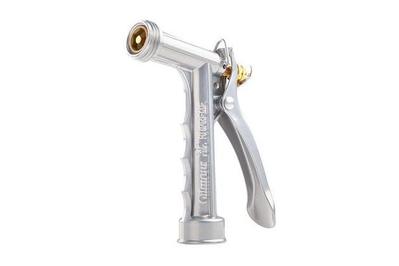
Over more than five years of being left outside—on the ground, in the mud—getting dropped on concrete, and submerged in everything from 5-gallon buckets to kids' plastic pools, the Gilmour Full Size Zinc Pistol Grip Nozzle works as well as on the day we bought it. And just to be sure, we bought another one in early 2020. Still great. Actually, it's better: The Gilmour nozzle now comes with a rubber collar on the tip, which would have been really handy to have that time we dropped the old one on the hood of a car, leaving a nice scratch as a lesson to us all.
This Gilmour nozzle lacks the typical rotating clock face of settings. Instead, it operates on a continuously variable trigger that alters the spray pattern the harder you press: Lightly squeezed, it sprays a broad mist pattern. Fully depressed, it shoots a concentrated beam that can soak trees 20 feet away. In side-by-side trials with traditional nozzles, we found that this Gilmour nozzle's design allowed it to do a far better job compensating for weak or inconsistent water pressure. You can adjust the overall spray pattern by tightening or backing off a set screw, which changes how much of the spray aperture you're opening and shutting with each squeeze. That allows you to dial in a good range of spray patterns at any water pressure or to customize it for the application. If you want to spray continuously, a wire clip can hold the trigger fully depressed.
This Gilmour nozzle is perfect for big, broad spraying work where you don't mind spilling a little water in the process: washing the car, watering a large area of lawn and trees, hosing down a sidewalk or patio. Where it falls flat is on targeted, short-range tasks like watering a few container plants on a balcony. On those jobs, the Melnor XT451 is better, as this Gilmour model tends to produce either a too-broad spray pattern that wets things other than your target or a too-strong beam that blasts divots in the dirt around plant roots. But what the Gilmour lacks in versatility, it makes up for in durability. As our five-year-old test unit proves, there's very little on the Gilmour that can break, and it truly doesn't need delicate handling to last you for years (although you may need to replace the rubber gasket after a while). Zinc can corrode after heavy exposure to saltwater, so if you live near the ocean, you might opt for the hardened-plastic marine version of this nozzle.
Also great: Melnor R301 RelaxGrip Metal Thumb-Control 8-Pattern Nozzle
Our pick: Eley Portable Garden Hose Reel Cart

Our pick
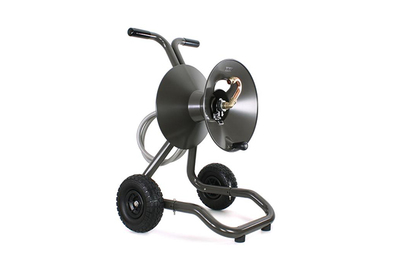
It may be tempting to buy an inexpensive hose reel, but in our experience they've been flimsy, difficult to use, and frustrating. We had almost given up on hose reels as a category, but then we found the Eley Portable Garden Hose Reel Cart (as well as the wall-mounted version, if that's a better fit for you). Eley reels sit at the top of the garden-gear pantheon, and for good reason. Through a combination of high-quality materials and an attention to detail found only in high-end products, the Eley reels solve nearly all of the issues commonly associated with hose reels. The Eley reel cart is stable, it moves easily, the reeling action is smooth with a free-spinning handle, and the overall build quality, durability, and ease of use are all outstanding. During our research, we were initially suspicious of the high cost, but once we began testing the Eley reel cart, we could see an investment in it being justified for those who want to solve all of their hose-reel problems over the long term with a single purchase.
The Eley reel cart is built for a lifetime of use. The majority of the parts are either brass, aluminum, or stainless steel. It comes with a high-quality 6.5-foot leader hose and flat-free tires. Most of the parts have a powder-coated finish, and there is really nothing on the cart that should rust. Eley backs it with a 10-year no-leak guarantee.

In action, the reel is easy to use. When we pulled in 100 feet of hose, we still needed to brace the frame with our foot, but only for the first 25 feet or so; after that, it just reeled right in. The cheaper models we've used, in contrast, needed us to brace them in at least two spots for about the first 50 feet. The Eley cart's handle spins freely, so it doesn't apply rug burn to your hand, and since the sides of the reel angle inward toward the center, the hose is unlikely to jump over the edge, something that happened to us more than once with the inexpensive Suncast reel we used to recommend. The Eley cart also comes with an adjustable brake that sets the resistance of the reel so that it reels out only what you want and doesn't keep spinning once you stop pulling the hose.
The Eley cart moves around a yard with no problem. The large tires, the handle placement, and the center of gravity make for an action that's as easy as using an empty two-wheel dolly. In our tests, on an especially uneven section of lawn, the Eley cart bumped its way around and got to its destination with no issue.
The standard configuration of the Eley reel fits 125 feet of ⅝-inch hose. An available extra-capacity kit (simply a wider reel) can fit up to 200 feet.
If there is a downside to the Eley reel, it's the cost. Currently sold for roughly $325—up almost 20% from its price in 2021—the two-wheel cart is almost 10 times the price of the plastic Suncast hose reel found in big-box stores nationwide. (The wall-mounted Eley reel costs $200 or so; that version is showing a similar increase from previous years.) The Eley reel is not for everyone, but we're convinced that some people—whether through an appreciation of high-quality gear, an impatience with inexpensive plastic goods, or just daily use of their garden hose—will find that the durability, features, and overall usability make it a worthwhile investment.
Also great: Hoselink 82ft Retractable Hose Reel

Also great
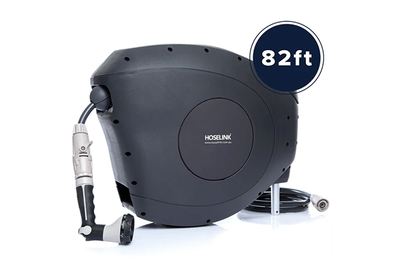
Another quality hose-reel option is the Hoselink 82ft Retractable Hose Reel. Unlike the Eley reel, the Hoselink reel retracts the hose automatically, making it not only convenient but also a nice option for people with limited strength or mobility. The hose pulls out easily and returns to the reel with a slight tug, like a window blind. As it reels in, a guide roller moves from side to side as the hose enters the housing, ensuring that it spools on evenly. The reel comes with 6.5 feet of leader hose, a decent enough hose nozzle, and a quick-connect system that makes it easy to detach the hose from the spigot or to remove the nozzle. We also like that the Hoselink can be mounted at any height, eliminating the need for the user to bend over to deal with the hose or the reel. The Hoselink reel attaches to the side of a house or a sturdy fence post with four screws and can rotate from side to side.
The Hoselink reel offers an easy way to manage a lot of hose. The hose pulled out easily in our tests, and when we were done, the wait was only five or 10 seconds before the whole thing was reeled back in and we were on our way to our next task. It was nice not to have to deal with a hose in the yard. As appealing as the Eley reel is, we tended not to reel that hose back in after every use, but with the Hoselink reel, we did because it's so easy. We also like that the nozzle end of the hose rotates freely, so you can turn the nozzle without also rotating the hose.
As mentioned earlier, another advantage of the Hoselink is that it allows you to install it at any height. We put it at chest height, and after a couple of days, we realized how nice it was not to bend down to get the hose, reel it in, or turn on the hose spigot. We were able to go through the entire watering process standing straight up, with almost no physical strain at all. It's for these reasons that we think the Hoselink reel combined with the Melnor R301 nozzle makes a great combination for someone with limited mobility or hand strength.
The Hoselink hose itself offers okay quality and doesn't match the flexibility of the Continental hose or the overall greatness of the Eley hose. But because of the reel's retractable nature, it doesn't need those things. Since this hose spends its days in the safe cocoon of the enclosed reel, it's far less likely to be roughly dragged across a driveway, accidentally left out for an entire winter, or driven over by a car. And because this hose is never manually looped, it doesn't really matter that this hose is not as flaccid as the others we tested.
The downside of the Hoselink is that the hose's diameter is smaller than that of our other picks—½ inch as opposed to ⅝ inch. This means that some tasks, especially filling buckets and the like, will take longer. We timed the Hoselink filling a 5-gallon bucket and did the same with the Continental hose, and the Hoselink took twice as long, about 2 minutes 15 seconds. Giraffe Tools has a similar retractable reel with a ⅝-inch hose; we did not test that model.
The Hoselink reel costs around $230, which is a solid amount of money. But it offers a lot, too, including 82 feet of hose, which isn't cheap. Considering the amount of convenience that the Hoselink reel provides, we believe that the cost is justified if using it would benefit your lifestyle.
Care and maintenance

A hose stored off the ground, out of the elements, and drained between uses will last longer. Ultraviolet rays can deteriorate even a properly drained and coiled hose, so storing it under some kind of shelter is a good idea. Although hose manufacturers usually recommend completely disconnecting both ends of the hose between uses, some people like to keep a nozzle on the hose at all times because doing so can help protect the couplings' threads from being scuffed on asphalt or pavement and can prevent critters from burrowing inside. For winter storage, Wirecutter senior staff writer Doug Mahoney likes to tie the whole coil together with a length of Romex (electrical wire)—"the twist tie of the gods," as Doug puts it.
No matter how well you take care of your hoses and nozzles, you'll occasionally need to replace a gasket to stop any leaks that have emerged, since the gaskets either wear out or go missing. We recommend picking up a pack of gaskets, like these Danco ⅝-inch Hose Washers, the next time you're at the hardware store. The effort-to-satisfaction ratio is off the charts with this fix. For about 20¢ and 20 seconds of work, you're solving a problem that prompts literally hundreds of hose and nozzle buyers to return or discard their "defective, leaking" purchases.
Here's another handy pair of accessories to know about: the male thread repair kits and female thread repair kits that, for a few bucks, you can buy packaged with a hose clamp at most hardware stores. If you have a hose with a leak (like the one we accidentally put a pitchfork tine through), you can cut off the damaged area and fix the rest with one of these kits. Or if you need to simply cut a short length off a garden hose—to make a little section that you can use to drain out a dehumidifier, for example—these kits can get your "new" hoses up and running in no time.
The competition
The Craftsman Premium Rubber Garden Hose, a former pick in this guide, suffered availability issues for years and now appears to be discontinued. It was almost identical to the Continental hose, with the same flexibility, kink resistance, and durability.
The Flexzilla Garden Hose used to be our top pick, but after a couple of years of use, it's not doing well. It's still lightweight and flexible, and its coupling hardware is still solid, but this hose's stiff sidewalls have degraded enough that its tendency to fold flat and block water has become increasingly frequent and frustrating. We've also found that the Flexzilla's slightly porous outer jacket tends to accumulate filth—maybe not more so than the exteriors of most hoses, but more visibly because of this hose's chartreuse color. Our main reservation comes down to the Flexilla's longevity, because we want to recommend a hose that lasts at least as long as a standard high-quality rubber option.
We had originally named the Hospaip Expandable Garden Hose as an expandable-hose pick. Unfortunately, even though it seemed durable in our initial tests, it quickly succumbed to the same rips and leaks that seem to plague every expandable or "pocket" hose. If you want something that's easy to store, stick with the HoseCoil.

Although the Gilmour Flexogen Super Duty Hose handled well enough, the steel spring coils on the end—intended to prevent kinking on and near the fittings—made us bleed when we tried to unscrew the hose from the spigot. No thanks.
The Teknor Apex NeverKink Heavy Duty felt great to handle, and the sleek yellow racing stripe down the middle made us feel like gardening champions. But it was almost too firm—knocking over patio furniture and stubbornly catching on branches and thorns. And on the occasion that it did kink (despite its name), we found undoing those knots and tangles to be difficult.
The Teknor Apex zero-G looks like it should be an expandable hose, even though it isn't one. It's a good, flexible hose overall, and some hardware-store employees we spoke with even recommended it as a better alternative to an expandable hose. Although it's lightweight and generally reliable, nothing about it stood out enough for us to make it a pick.

The Water Right 600 Series Polyurethane Garden Hose seemed almost too good to be true—in our tests, it was durable, sturdy, and remarkably easy to maneuver. But once this hose finally kinked, it was difficult to straighten out, a problem we've seen repeated in negative owner reviews. And at the time of our research, the Water Right cost $100, which is way too much to pay for a flawed hose.
In previous years, we tested and dismissed the GatorHyde Drinking Water Safe Hose and the Scotts MaxFlex Heavy Duty Garden Hose (both discontinued), as well as a rubber/PVC hose from Gilmour. We briefly recommended the Tuff-Guard Perfect Garden Hose, but it ended up leaking during long-term testing.
We previously recommended the Suncast Hosemobile Hose Reel Cart, but after years of using it, we've come to realize just how lacking it is. This cart is adequate, and it's about the best you can get for the sub-$50 price, but it's marred by too many of the flaws that plague all inexpensive hose reels, as it's unstable, takes too much effort, and feels kinda flimsy. Not everyone has the budget for an Eley hose reel or a Hoselink retractable model, and this is a barebones hose reel available at a much, much lower price. But aside from the fact that it barely functions, nothing about it sets it apart. In other words, if you're after a low-budget hose reel, get this one, but keep in mind that it comes with a lot of frustrations—too many for us to wholeheartedly endorse it.
We didn't test the Giraffe Tools Retractable Hose Reel. It looks similar to the Hoselink but has a larger-diameter hose: ⅝ inch as opposed to ½ inch. Although it lacks a quick-connect system, it otherwise looks like a decent option. Typically it sells for about $40 less than the Hoselink.
As for other hose reels, we also looked at models made by Liberty, including the 880-2 2-Wheel Garden Hose Reel Cart and the decorative 301 2-Wheel Garden Hose Reel Cart. These carts aren't as expensive as the Eley, but they're still in the $150 to $200 range. Overall, customer reviews of the Liberty reels aren't anywhere near as stellar as those of the Eley cart, with mentions of rusting over time and leaking. Even though the Eley reel costs more, its quality (backed by Eley's 10-year warranty) makes it the better purchase.
In 2022, we tested the Melnor 65112-AMZ Vortex Rear-Trigger 6-Pattern Nozzle, a nice, high-quality hose nozzle centered on a new vortex spray pattern. The spray on this setting is a swirling stream of water, similar to what you get from the all-purpose cleaning tip found on many pressure washers. We found it a fun setting to play around with, but ultimately it doesn't bring much to the table. There was nothing we could do with it that we couldn't do with the regular settings.
The other hose nozzles we tested included the Melnor 65032-AMZ, which had the all-metal simplicity of the Gilmour Full Size Zinc Pistol Grip Nozzle but also the assorted settings of the Melnor XT451. It was a fine nozzle in our tests, but its spray selections weren't as varied or nice as those of the XT451, and it was more expensive than the Gilmour. It's no longer listed on the Melnor website.
The Gardenite 10-Pattern Hand Sprayer and the Dramm 12704 9-Pattern Spray Nozzle were also decent, but their spray patterns weren't as consistent as what we saw from the Melnor XT451, and neither model had the same heavy-duty feel. During our testing, water often dribbled out of the front of the Gardenite while we were using it, getting our hands—and sometimes our pants—needlessly wet.
This article was edited by Harry Sawyers.
Source: https://www.nytimes.com/wirecutter/reviews/the-best-garden-hose/

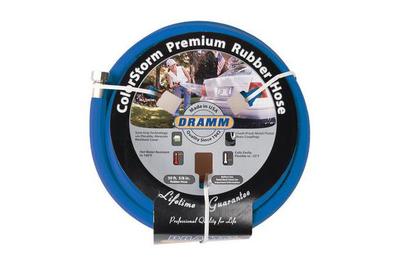

0 Response to "Ames Reel Easy Cassette Portable Hose Reel With 60 Hose Reviews"
Post a Comment